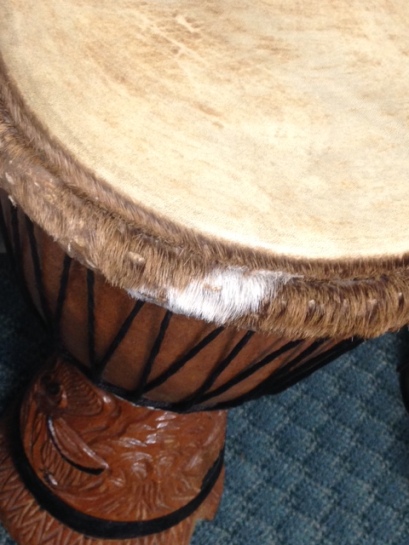In music therapy groups as well as individual music therapy sessions, I find that drumming is a great way to work on several goals/skills simultaneously. We are all rhythmic beings, and we all have an internal rhythm. Without realizing it we unconsciously tap our feet along to our favorite songs, we walk in rhythm and we even talk in rhythm. Rhythmic activities are great ways to help target motor functioning, speech and language, as well as cognition.
Drumming is a fun and great way to help improve general motor functioning. When striking a drum with drum sticks or hands, an individual is exercising their range of motion. Drums can also be positioned in a functional way to target specific functional movements such as crossing midline or working on reaching with a non-dominant arm. Keeping up with a steady beat can even help improve physical endurance and strength. One major difference of drumming vs. traditional exercise is that you are getting that immediate auditory feedback whenever the drum is being played, which in turn, can help motivate you to keep going.
The very elements of speech are even rhythmic. Syllables in words and sentences become rhythmic patterns and structures. Music itself is just like speech except words are elongated and pitches fluctuate more frequently. For someone who stuffers with aphasia or has general difficulty with expressive communication, drumming and rhythm can be used to help improve initiation of speech, articulation, and intelligibility. Rhythm and music are all very predictable, structural, and planned, which allows the individual to anticipate the rhythm and synchronize it with their speech.

Drumming and rhythmic exercises are also great for cognition and executive functioning skills. During a call and response activity, an individual would have to listen and be able to repeat a specific rhythm or rhythmic sequence, which targets attention skills and memory recall.
I think the best thing about drumming is that there are no wrong notes! Drums are approachable versus instruments that have notes or strings. Drums are easy to learn for people who may never played an instrument before and there are so many different types of drums you can use! You can use frame drums, djembes, tubanos, or cajons, etc.. Having many different types of drums offers several options and different options allows individuals to find a drum that they are comfortable with. For anyone that may have physical limitations, I also always want to be able to modify or adapt the equipment I am using to make it a successful experience for that individual.
I have recently been implementing a new group with my older adults using exercise balls. It sounds kind of silly to drum on exercise balls, but it creates a fun, relaxing, and approachable music therapy group for everyone no matter their musical experience. I use exercise balls as drums and place them on top of square laundry baskets to help stabilize them and keep the balls from moving while group members hit the exercise balls with drum sticks. In this group we are all in a circle and group members must watch me and follow my rhythmic patterns and sequences while we drum to live or recorded music. This group is both a mind and body workout. My older adults really seem to enjoy it!

Anything can be turned into a drum! Drumming and rhythmic activities are great ways to keep us exercising our body and minds no matter our age or abilities!
–Courtney



